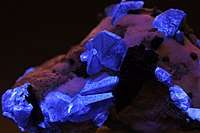Benitoite
Benitoite (/bəˈniːtoʊaɪt/) is a rare blue barium titanium cyclosilicate, found in hydrothermally altered serpentinite. It forms in low temperature, high pressure environments typical of subduction zones at convergent plate boundaries. Benitoite fluoresces under short wave ultraviolet light, appearing bright blue to bluish white in color. The more rarely seen clear to white benitoite crystals fluoresce red under long-wave UV light.
| Benitoite | |
|---|---|
 Benitoite on natrolite | |
| General | |
| Category | Cyclosilicate |
| Formula (repeating unit) | BaTiSi3O9 |
| Strunz classification | 9.CA.05 |
| Crystal system | Hexagonal |
| Crystal class | Ditrigonal dipyramidal (6m2) H-M symbol: (6 m2) |
| Space group | P6c2 |
| Unit cell | a = 6.641, c = 9.7597(10) [Å]; Z = 2 |
| Identification | |
| Color | Blue, colorless |
| Crystal habit | Tabular dipyramidal crystals, granular |
| Twinning | On {0001} by rotation |
| Cleavage | [1011] poor |
| Fracture | Conchoidal |
| Mohs scale hardness | 6 - 6.5 |
| Luster | Vitreous |
| Streak | White |
| Diaphaneity | Transparent to translucent |
| Specific gravity | 3.65 |
| Optical properties | Uniaxial (+) |
| Refractive index | nω = 1.756 - 1.757 nε = 1.802 - 1.804 |
| Birefringence | δ = 0.046 |
| Pleochroism | O = colorless; E = purple, indigo, greenish blue |
| Dispersion | 0.036–0.046[1] |
| Solubility | Insoluble: HCl, H2SO4 Soluble: HF |
| Other characteristics | Blue fluorescence under SW UV; intense blue cathodoluminescence |
| References | [2][3][4] |
It was discovered in 1907 by prospector James M. Couch in the San Benito Mountains roughly halfway between San Francisco and Los Angeles. Couch originally believed the mineral was a corundum mineral known as sapphire due to its resemblance of color. In 1909, a sample was sent to the University of California, Berkeley where mineralogist Dr. George D. Louderback realized it was a previously unknown mineral. Corundum (sapphire) has a defined Mohs hardness of 9, while benitoite is much softer. He named it benitoite for its occurrence near the headwaters of the San Benito River in San Benito County, California.[5][6]
Benitoite occurs in a number of isolated locations globally, but gemstone quality material has only been found in California at the Benito Gem Mine where it was first discovered. It has been correctly identified in Montana, Arkansas, Japan, and Australia although they formed under slightly different conditions and only grow large enough to be considered an accessory mineral. In 1985 benitoite was named as the official state gem of California.[7][8]
Benitoite has a rare 5 pointed twinned crystal form, and an even rarer 6 pointed twinned crystal form, "star of David".
Associated minerals and locations
Benitoite typically occurs with an unusual set of minerals, along with minerals that make up its host rock. Frequently associated minerals include: natrolite, neptunite, joaquinite, serpentine and albite.
Benitoite is a rare mineral found in very few locations including San Benito County, California, Japan and Arkansas. In the San Benito occurrence, it is found in natrolite veins within glaucophane schist within a serpentinite body. In Japan, the mineral occurs in a magnesio-riebeckite-quartz-phlogopite-albite dike cutting a serpentinite body.[4]
 Blue benitoite crystals on white natrolite, Dallas Gem Mine, San Benito Co., California, US
Blue benitoite crystals on white natrolite, Dallas Gem Mine, San Benito Co., California, US Benitoite crystals under UV light
Benitoite crystals under UV light
References
| Wikimedia Commons has media related to Benitoite. |
- O'Donoghue, Matthew (2006). Gems: Their Sources, Descriptions and Identification (6th ed.). Oxford: Butterworth-Heinemann. p. 389. ISBN 978-0-75-065856-0.
- WebMineral Listing
- MinDat Listing
- Handbook of Mineralogy
- Louderback, George Davis (July 30, 1907). "Benitoite, A New California Gem Mineral". Bulletin of the Department of Geology. University of California Publications. 5 (9): 149–153. OCLC 6255540.
- Wilkins, Al (March 23, 2002). "SCFM News March 02, Featuring Benitoite". Mineralogical Society of Southern California. Archived from the original on May 16, 2013. Retrieved April 3, 2014.
- "Mineral Resources". California Department of Conservation - California Geological Survey. Archived from the original on August 21, 2008. Retrieved April 3, 2014.
- "Benitoite". Gemology Online. Retrieved 8 November 2012.